Unregulated Urban Regeneration in Athens: Greening and Taxation of the Built Environment as Impending Levers of Increasing Inequalities
Abstract
1. Introduction
2. Materials and Methods
2.1. Energy Performance Certificate (EPC) Registry
2.2. Building Permits Registry
2.3. Objective Real Estate Property Values (OREPV)
2.4. Social Types of Residential Areas
2.5. Analyzing the Aged and Outdated Housing Stock: Socio-Spatial Facts About the Energy Performance of Dwellings
3. Results
3.1. Construction Activity: Dynamics in the City Center and Affluent Suburbs
3.2. The Shifting Landscape of Athens’ Housing Market and Sociospatial Differentiations
3.3. Policies Leading Urban Regeneration Processes
3.3.1. “Exikonomo” Program: Inclusions and Exclusions of the Energy Upgrade Funding (EUF)
3.3.2. Objective Real Estate Property Values (OREPV) as a Tool for Leading Regeneration
4. Discussion
Author Contributions
Funding
Data Availability Statement
Conflicts of Interest
| 1 | The OREPV urban index was calculated using QGIS 3.2 tools of spatial analysis. In more detail, we combined 3 distinct basemaps: the linear OREPV (15 m. buffer zone), the circular ORPV and the 2011 URANUS. This procedure was applied to both the 2018 and 2021 OREPV basemaps and their corresponding values. Our goal was to calculate a OREPV urban index for each URANU. First, we intersected the three basemaps and then we “reconstructed” the URANU basemap attributing a OREPV urban value to each URANU. This value, that we named OREPV urban index, equals the average of the values of the linear and circular OREPV intersecting with each URANU, weighted by their part to the total URANUS surface. |
References
- Kalfa, K. Self-Sheltering Now! The Invisible Side of American Aid to Greece (in Greek); Futura: Athens, Greece, 2019. [Google Scholar]
- Mantouvalou, M.; Mavridou, M.; Vaiou, D. Processes of Social Integration and Urban Development in Greece: Southern European Challenges to European Unification. Eur. Plan. Stud. 1995, 3, 189–204. [Google Scholar] [CrossRef]
- Allen, J.; Barlow, J.; Leal, J.; Maloutas, T.; Padovani, L. Housing and Welfare in Southern Europe; Blackwell: Oxford, UK, 2004; ISBN 978-1-4051-0307-7. [Google Scholar]
- Siatitsa, D. Claims for the ‘Right to Housing’ in Cities of Southern Europe: Discourse and Impact of Social Movements; National Technical University of Athens (NTUA): Athens, Greece, 2014. [Google Scholar]
- Siatitsa, D.; Tulumello, S.; Colini, L. Private Profit vs Social Value. In Housing as an Investment in Greece and Southern Europe; FEPS/ ETERON: Athens, Greece, 2025. [Google Scholar]
- Maloutas, T. Athens. A Rapidly Changing Metropolis in the European South; Maloutas, T., Ed.; Routledge: London, UK, 2025; ISBN 9781032659848. [Google Scholar]
- Economou, D. Land and Housing System. In The Problems of Welfare State Development in Greece (in Greek); Maloutas, T., Economou, D., Eds.; Exadas: Athens, Greece, 1988; pp. 57–114. [Google Scholar]
- Mantouvalou, M. Urban Land Rent, Land Prices and Urban Space Development Processes II: Problematic for Spatial Analysis in Greece (in Greek). Greek Rev. Soc. Res. 1996, 89, 53. [Google Scholar] [CrossRef][Green Version]
- Antonopoulou, S. The Building Industry in Greece: Its Role in the Post-War Greek Economy; University College London: London, UK, 1987. [Google Scholar]
- Maloutas, T.; Spyrellis, S.N. Vertical Segregation: Mapping the Vertical Social Stratification of Residents in Athenian Apartment Buildings. Méditerranée 2016, 127, 27–36. [Google Scholar] [CrossRef]
- Vatavali, F. Housing Production and Land Ownership during the Period 1990–2007. Social Dimensions of the Transformations in the City of Ioannina (in Greek). Geographies 2017, 28, 78–96. [Google Scholar]
- Polyzou, I.; Spyrellis, S.N. Housing Practices of Albanian Immigrants in Athens: An “in-between” Socio-Spatial Condition. Land 2024, 13, 964. [Google Scholar] [CrossRef]
- Kourachanis, N. Housing as a Base for Welfare in Greece: The Staircase of Transition and Housing First Schemes. Int. J. Hous. Policy 2022, 24, 596–616. [Google Scholar] [CrossRef]
- Emmanuel, D. Socio-Economic Inequalities and Housing in Athens: Impacts of the Monetary Revolution of the 1990s. Greek Rev. Soc. Res. 2004, 113, 121–143. [Google Scholar]
- Emmanuel, D. The Greek System of Home Ownership and the Post-2008 Crisis in Athens. Reégion Et Deéveloppement 2014, 39, 167–182. [Google Scholar]
- Chimoniti-Teroviti, S. Developments in the Housing Market; CRES: Athens, Greece, 2005. [Google Scholar]
- Kandylis, G.; Papatzani, E.; Polyzou, I. Between Coexistence and Marginality: Migrants and Socio-Spatial Change in Athens. In Athens A Rapidly Changing South European Metropolis; Maloutas, T., Ed.; Routledge: London, UK, 2024. [Google Scholar]
- Siatitsa, D.; Gyftopoulou, S.; Balampanidis, D.; Papatzani, E. For the Right to Affordable Rental Housing (a Summarised Version); ETERON: Athens, Greece, 2022. [Google Scholar]
- Alexandri, G. Housing Financialisation a La Griega. Geoforum 2022, 136, 68–79. [Google Scholar] [CrossRef]
- Pettas, D.; Avdikos, V.; Papageorgiou, A. Platform—Driven Housing Commodification, Financialisation and Gentrification in Athens. J. Hous. Built Environ. 2024, 39, 1541–1562. [Google Scholar] [CrossRef]
- Tulumello, S.; Dagkouli-Kyriakoglou, M. Housing Financialization and the State, in and Beyond Southern Europe: A Conceptual and Operational Framework. Hous. Theory Soc. 2024, 41, 192–215. [Google Scholar] [CrossRef]
- Tulumello, S.; Dagkouli-Kyriakoglou, M. Financialization of Housing in Southern Europe: Policy Analysis and Recommendations. Final Report—Submitted 28/01/2021; Project commissioned by the European Parliament, office of MEP José Gusmão (group The Left in the European Parliament): Brussels, Belgium, 2021. [Google Scholar]
- Wetzstein, S. The Global Urban Housing Affordability Crisis. Urban Stud. 2017, 54, 3159–3177. [Google Scholar] [CrossRef]
- Zhang, C.; Jia, S.; Yang, R. Housing Affordability and Housing Vacancy in China: The Role of Income Inequality. J. Hous. Econ. 2016, 33, 4–14. [Google Scholar] [CrossRef]
- Ferrera, M. The “Southern Model” of Welfare in Social Europe. J. Eur. Soc. Policy 1996, 6, 17–37. [Google Scholar] [CrossRef]
- Sequera, J.; Nofre, J. Urban Activism and Touristification in Southern Europe. In Contemporary Left-Wing Activism Vol 2; Routledge: London, UK, 2018; pp. 88–105. [Google Scholar]
- Grossmann, K. Energy Efficiency for Whom? A Conceptual View on Retrofitting, Residential Segregation and the Housing Market. Sociol. Urbana Rural. 2019, 119, 78–95. [Google Scholar] [CrossRef]
- Bouzarovski, S.; Frankowski, J.; Tirado Herrero, S. Low-Carbon Gentrification: When Climate Change Encounters Residential Displacement. Int. J. Urban Reg. Res. 2018, 42, 845–863. [Google Scholar] [CrossRef]
- Bergoënd, A. Renovictions in Europe. Briefing, FEANTSA, 2022. Available online: https://www.feantsa.org/public/user/Resources/reports/2022/2_Briefing_-_Renovictions_in_Europe.pdf (accessed on 20 February 2025).
- Burbidge, M.; Papantonis, D.; Petrova, S.; Bouzarovski, S.; Apostoliotis, A.; Flamos, A. Gender-Blind Energy Efficiency Policy-Making in Europe: Risks and Challenges for the Private Rented Sector. In Proceedings of the European Council for an Energy Efficient Economy—Summer Study, Chamouille, France, 10–15 June 2024. [Google Scholar]
- von Platten, J.; Mangold, M.; Johansson, T.; Mjörnell, K. Energy Efficiency at What Cost? Unjust Burden-Sharing of Rent Increases in Extensive Energy Retrofitting Projects in Sweden. Energy Res. Soc. Sci. 2022, 92, 102791. [Google Scholar] [CrossRef]
- Gustafsson, J. Renovations as an Investment Strategy: Circumscribing the Right to Housing in Sweden. Hous. Stud. 2021, 39, 1555–1576. [Google Scholar] [CrossRef]
- Charles, H.; Bouzarovski, S.; Bellamy, R.; Gormally-Sutton, A. ‘Although It’s My Home, It’s Not My House’—Exploring Impacts of Retrofits with Social Housing Residents. Energy Res. Soc. Sci. 2025, 119, 103869. [Google Scholar] [CrossRef]
- Maloutas, T.; Spyrellis, S. Inequality and Segregation in Athens: Maps and Data. In Athens Social Atlas. Digital Compendium of Texts and Visual Material; Maloutas, T., Spyrellis, S., Eds.; Athens Social Atlas: Athens, Greece, 2019. [Google Scholar]
- Maloutas, T.; Spyrellis, S.N. Segregation Trends in Athens: The Changing Residential Distribution of Occupational Categories during the 2000s. Reg. Stud. 2019, 54, 462–471. [Google Scholar] [CrossRef]
- EKKE (National Centre for Social Research)—ELSTAT (Hellenic Statistical Authority) Panorama of Greek Census Data 1991–2011. Internet Appl. Access Map Census Data 2015. Available online: https://panorama.statistics.gr/en/ (accessed on 3 November 2024).
- ELSTAT (Hellenic Statistical Authority). The Results of the Census, Population and Residences 2021 (in Greek); ELSTAT (Hellenic Statistical Authority): Athens, Greece, 2023. [Google Scholar]
- Chatzikonstantinou, E.; Katsoulakos, N.; Vatavali, F. Housing, Energy Performance and Social Challenges in Greece. A Quantitative Approach. E3S Web. Conf. 2023, 436, 01015. [Google Scholar] [CrossRef]
- Vaiou, D.; Mantouvalou, M.; Mavridou, M. Athens 2004. On the Traces of Globalisation? (In Greek). Geographies 2004, 7, 13–25. [Google Scholar]
- Delladetsimas, P.M. The Current Dynamics of Athens’ Development: Conventional-New Model and Infrastructure Projects (in Greek). Geographies 2004, 7, 48–64. [Google Scholar]
- ELSTAT (Hellenic Statistical Authority) 2021 Population-Housing Census. Available online: https://www.statistics.gr/en/2021-census-pop-hous (accessed on 19 November 2024).
- Mantouvalou, M. Urban Land Rent, Land Prices and Urban Space Development Processes I: Theory through the Greek Experience (in Greek). Greek Rev. Soc. Res. 1995, 88, 33–59. [Google Scholar]
- ELSTAT (Hellenic Statistical Authority). Notary Activities: Year 2023 (in Greek); ELSTAT (Hellenic Statistical Authority): Athens, Greece, 2024. [Google Scholar]
- Bank of Greece Indices of Residential Property Prices: Q1 2024; Bank of Greece: Athens, Greece, 2024.
- Triantafyllopoulos, N. The Building Stock of Central Athens. In Athens Social Atlas. Digital Compendium of Texts and Visual Material; Maloutas, T., Spyrellis, S., Eds.; Athens Social Atlas: Athens, Greece, 2015. [Google Scholar]
- Dimitrakou, I. Vacancy, Access to Housing and Micro-segregation. Bull. Corresp. Hellénique Mod. Contemp. 2022, 43–66. [Google Scholar] [CrossRef]
- Tyrovolas, A. He “Golden Visa” Policy in Greece: Privileged Mobility; Harokopeio University of Athens: Athens, Greece, 2020. [Google Scholar]
- Pavlou, A. Real Estate: Who Are the Foreign Buyers in Greece? (in Greek). Oikon. Taxydromos 2024. Available online: https://www.ot.gr/2024/04/13/oikonomia/akinita/akinita-poioi-ksenoi-agorazoun-stin-ellada-pinakes-2/ (accessed on 25 November 2024).
- Alexandri, G. Planning Gentrification and the ‘Absent’ State in Athens. Int. J. Urban Reg. Res. 2018, 42, 36–50. [Google Scholar] [CrossRef]
- Pettas, D.; Avdikos, V.; Iliopoulou, E.; Karavasili, I. “Insurrection Is Not a Spectacle”: Experiencing and Contesting Touristification in Exarcheia, Athens. Urban Geogr. 2022, 43, 984–1006. [Google Scholar] [CrossRef]
- European Commission. A Renovation Wave for Europe—Greening Our Buildings, Creating Jobs, Improving Lives; European Commission: Bruxelles, Belgium, 2020. [Google Scholar]
- McCord, M.; Haran, M.; Davis, P.; McCord, J. Energy Performance Certificates and House Prices: A Quantile Regression Approach. J. Eur. Real Estate Res. 2020, 13, 409–434. [Google Scholar] [CrossRef]
- ELSTAT (Hellenic Statistical Authority). Energy Efficiency and Housing Difficulties; ELSTAT (Hellenic Statistical Authority): Athens, Greece, 2024. [Google Scholar]
- Chatzikonstantinou, E.; Katsoulakos, N.; Vatavali, F. Housing and Energy Consumption in Greece. Households’ Experiences and Practices in the Context of the Energy Crisis. IOP Conf. Ser. Earth Environ Sci. 2022, 1123, 012043. [Google Scholar] [CrossRef]
- Ozgunes, M.; Vrantsis, N. Energy Efficiency Renovation: Impact and Challenges in Greece. FEANTSA: Brussels, Belgium, 2022. [Google Scholar]
- Spitogatos.gr. The Impact of Energy Class on Property Values and Rental Prices in Athens; Spitogatos: Athens, Greece, 2024. [Google Scholar]
- Christoforaki, K. The Spatial and Social Footprint of the Energy Saving Program “Eksikonomisi Kat’ Oikοn”. In Athens Social Atlas. Digital Compendium of Texts and Visual Material; Maloutas, T., Spyrellis, S., Eds.; Athens Social Atlas: Athens, Greece, 2018. [Google Scholar]
- Vourgana, M. The Price List for Property Transfers (in Greek). Oikon. Taxidromos 2023. Available online: https://www.ot.gr/2023/06/17/forologia/forologia-eidiseis/o-timokatalogos-stis-metavivaseis-akiniton/ (accessed on 3 November 2024).
- Fernández, A.; Haffner, M.; Elsinga, M. Subsidies or Green Taxes? Evaluating the Distributional Effects of Housing Renovation Policies among Dutch Households. J. Hous. Built Environ. 2024, 39, 1161–1188. [Google Scholar] [CrossRef]
- Willand, N.; Moore, T.; Horne, R.; Robertson, S. Retrofit Poverty: Socioeconomic Spatial Disparities in Retrofit Subsidies Uptake. Build. Cities 2020, 1, 14–35. [Google Scholar] [CrossRef]
- Schleich, J. Energy Efficient Technology Adoption in Low-Income Households in the European Union—What Is the Evidence? Energy Policy 2019, 125, 196–206. [Google Scholar] [CrossRef]
- Kazepov, Y.; Verwiebe, R. Vienna; Routledge: London, UK, 2021; ISBN 9781003133827. [Google Scholar]
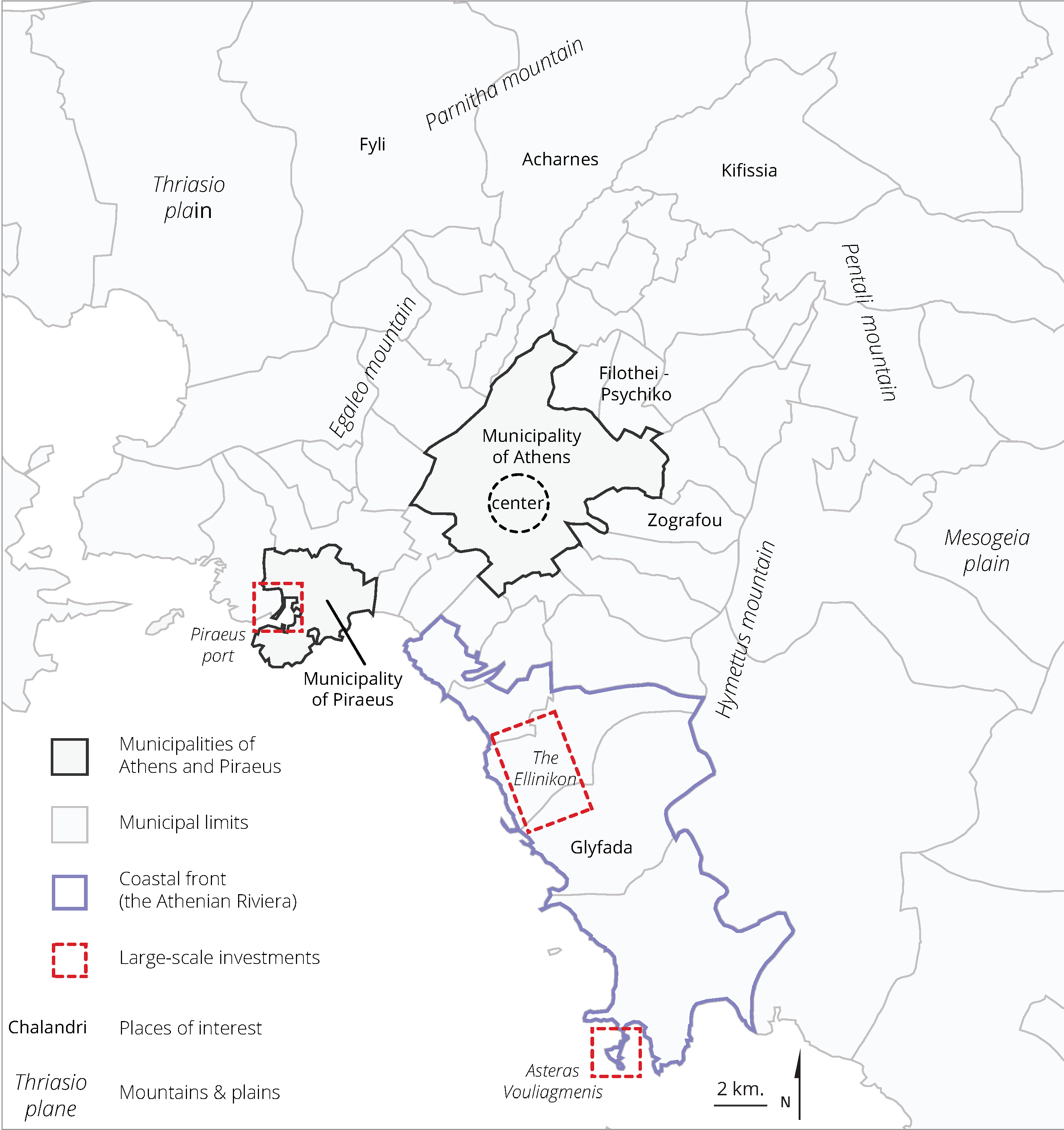
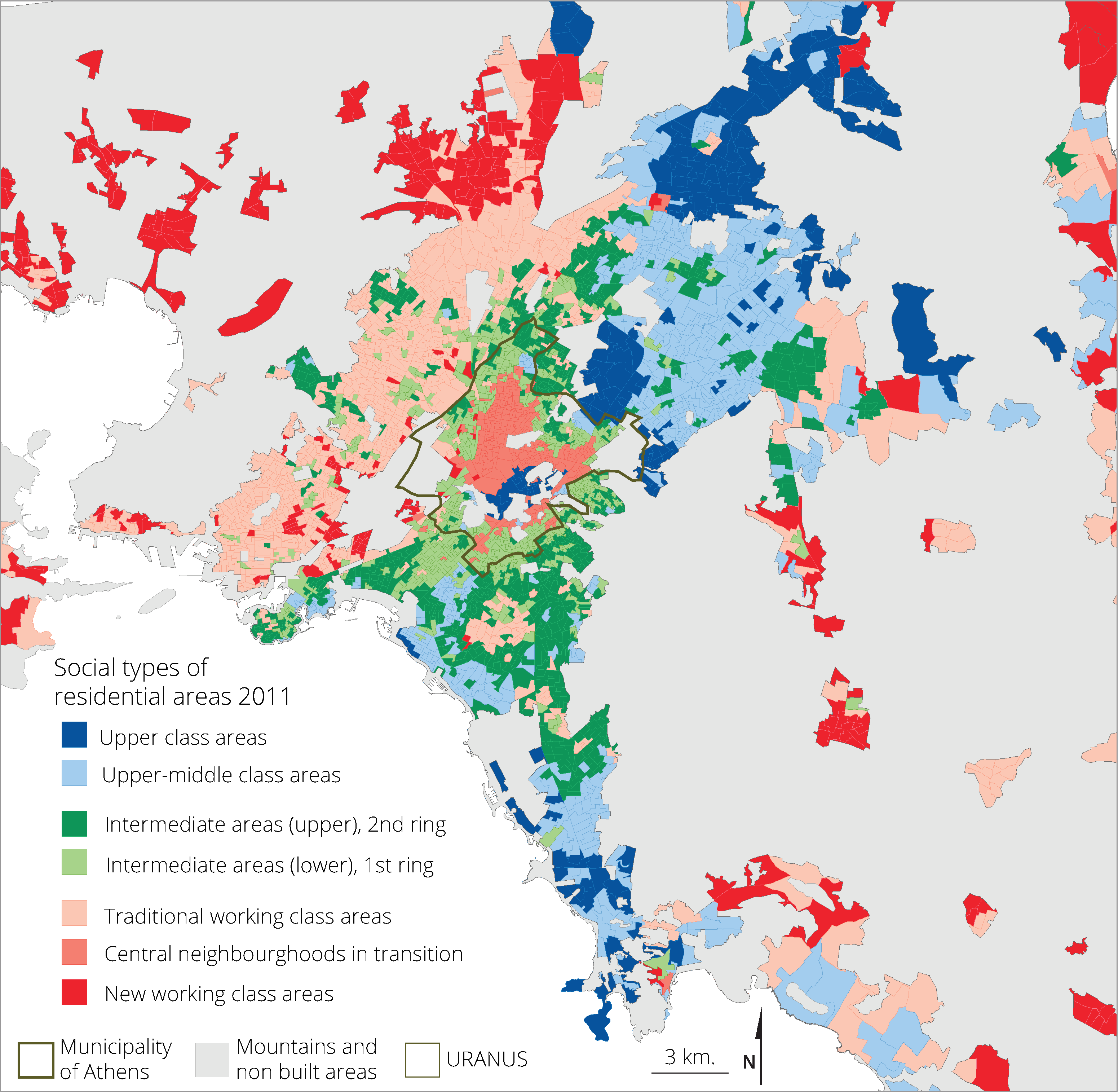
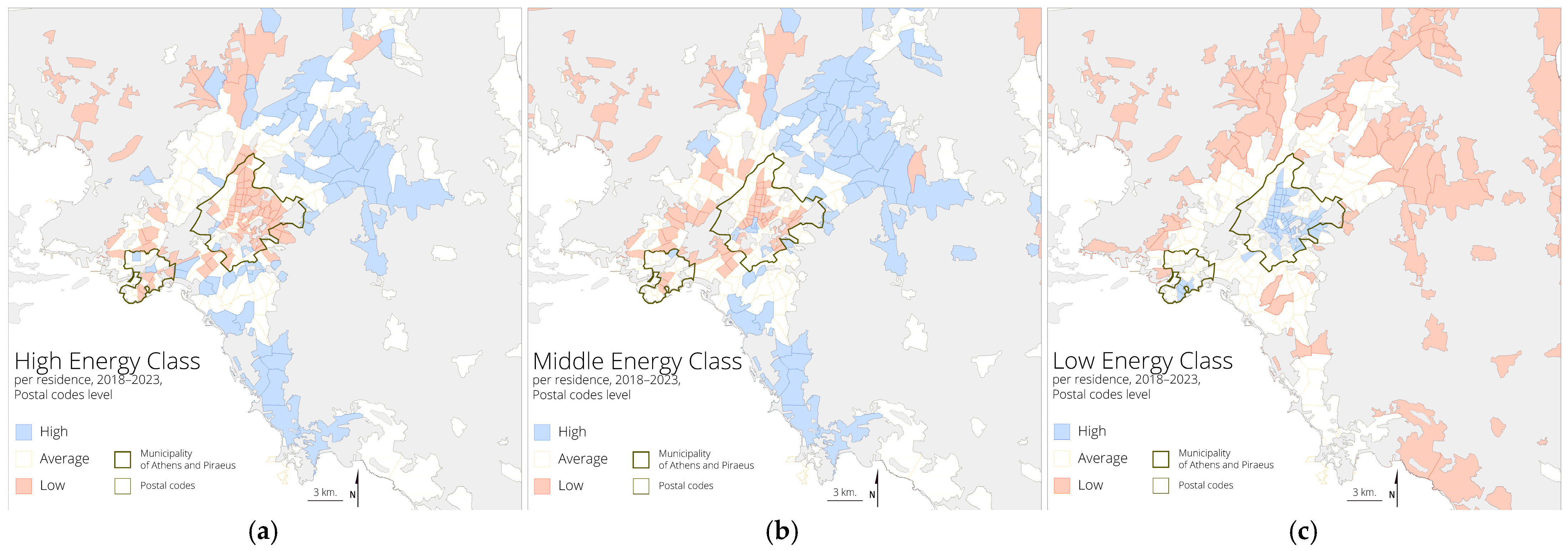
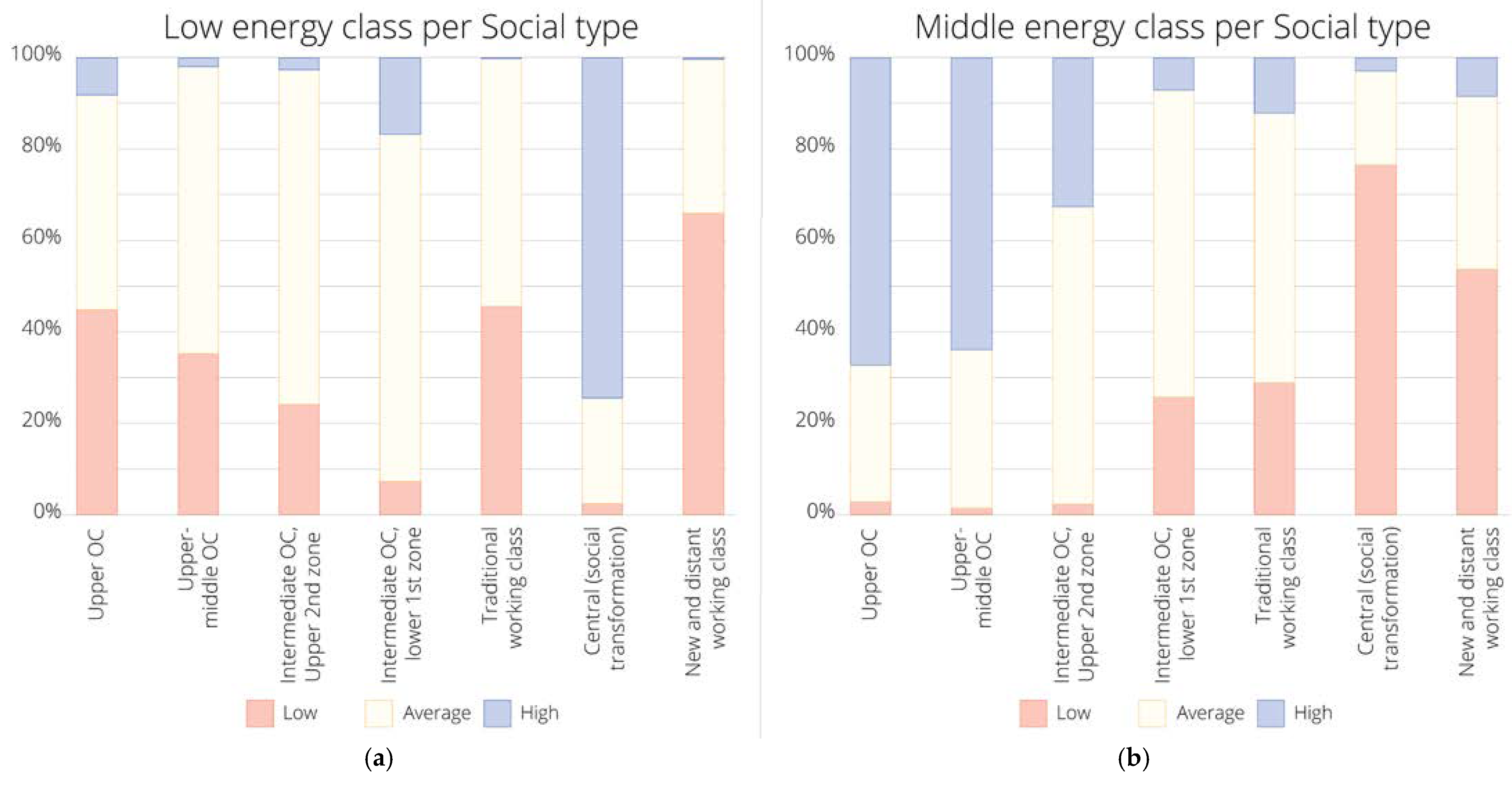
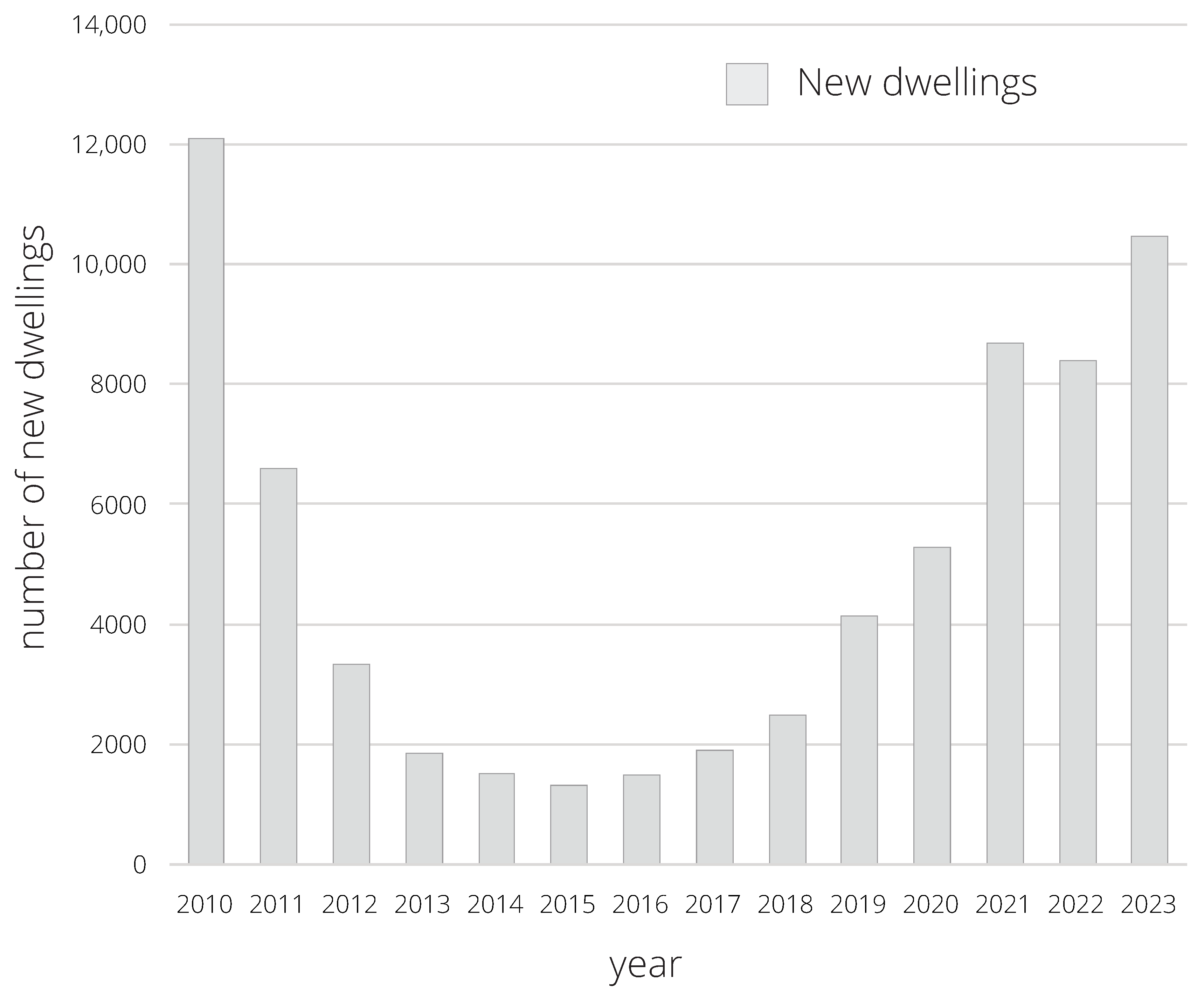
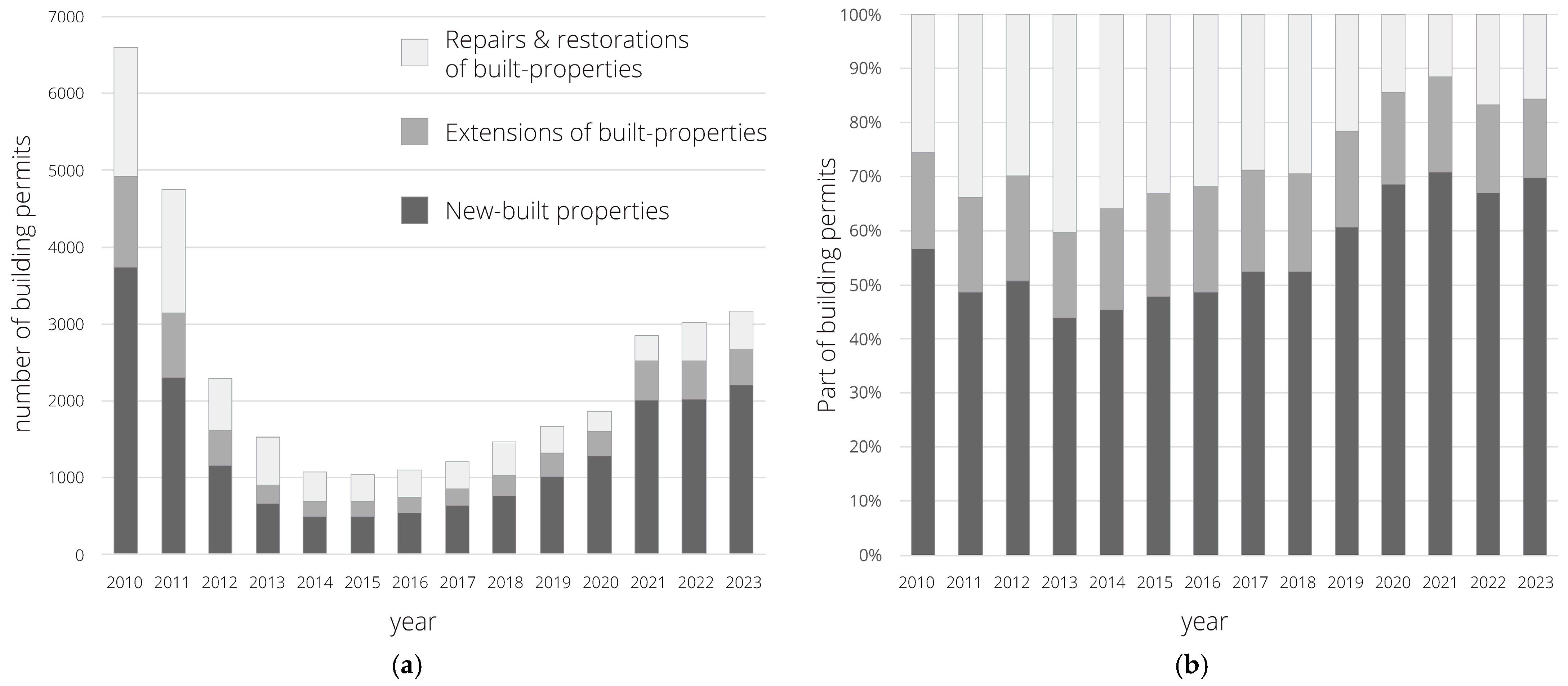
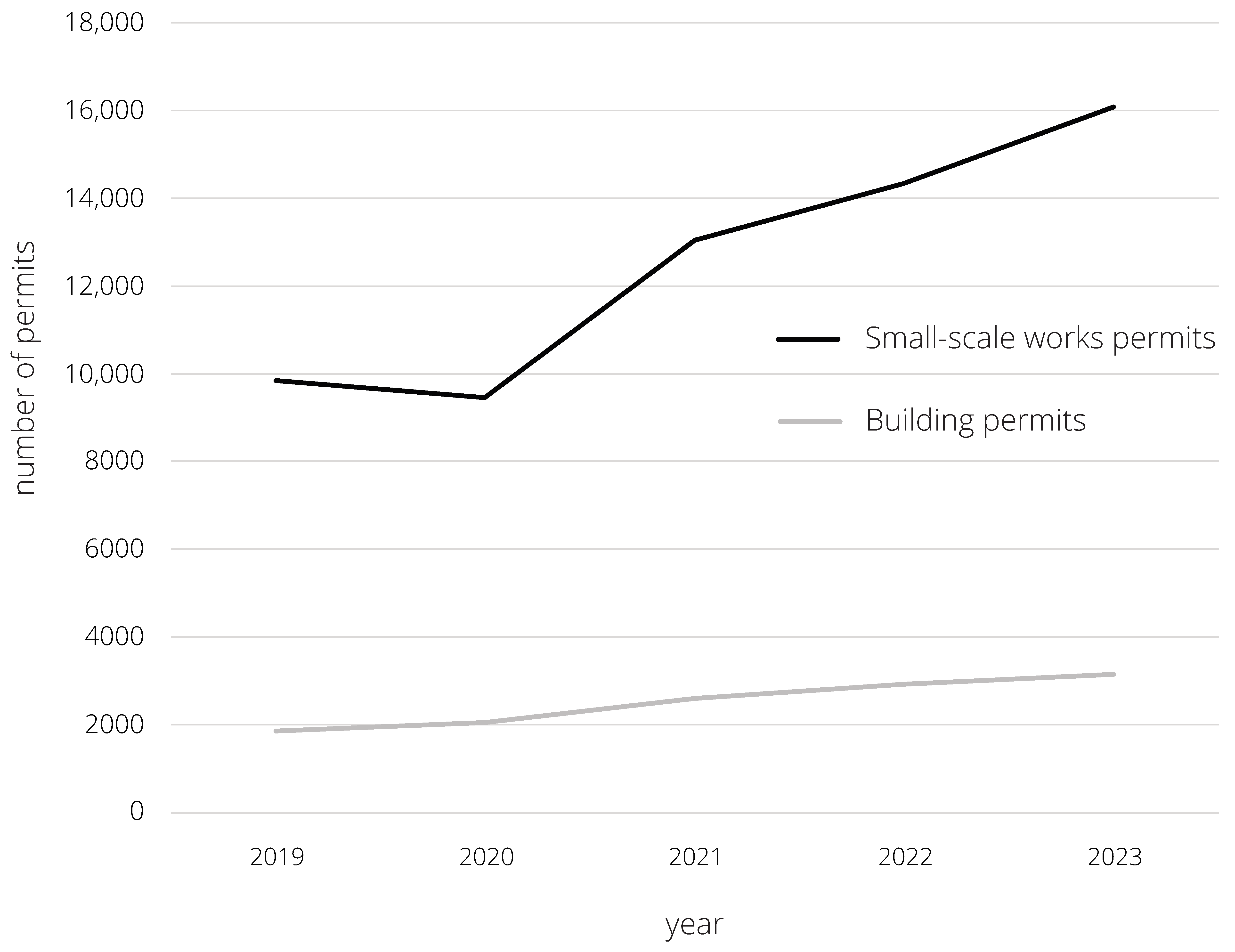
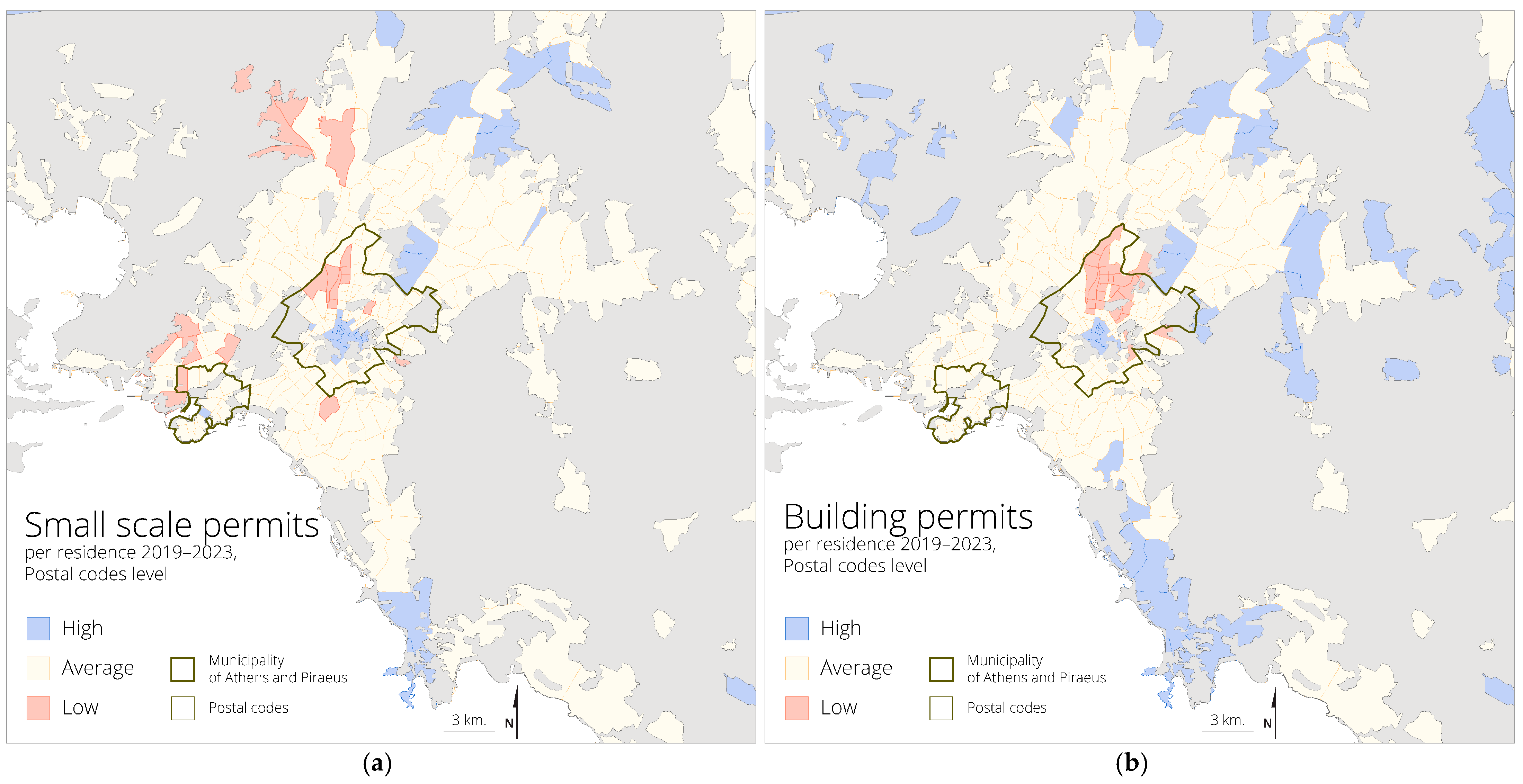
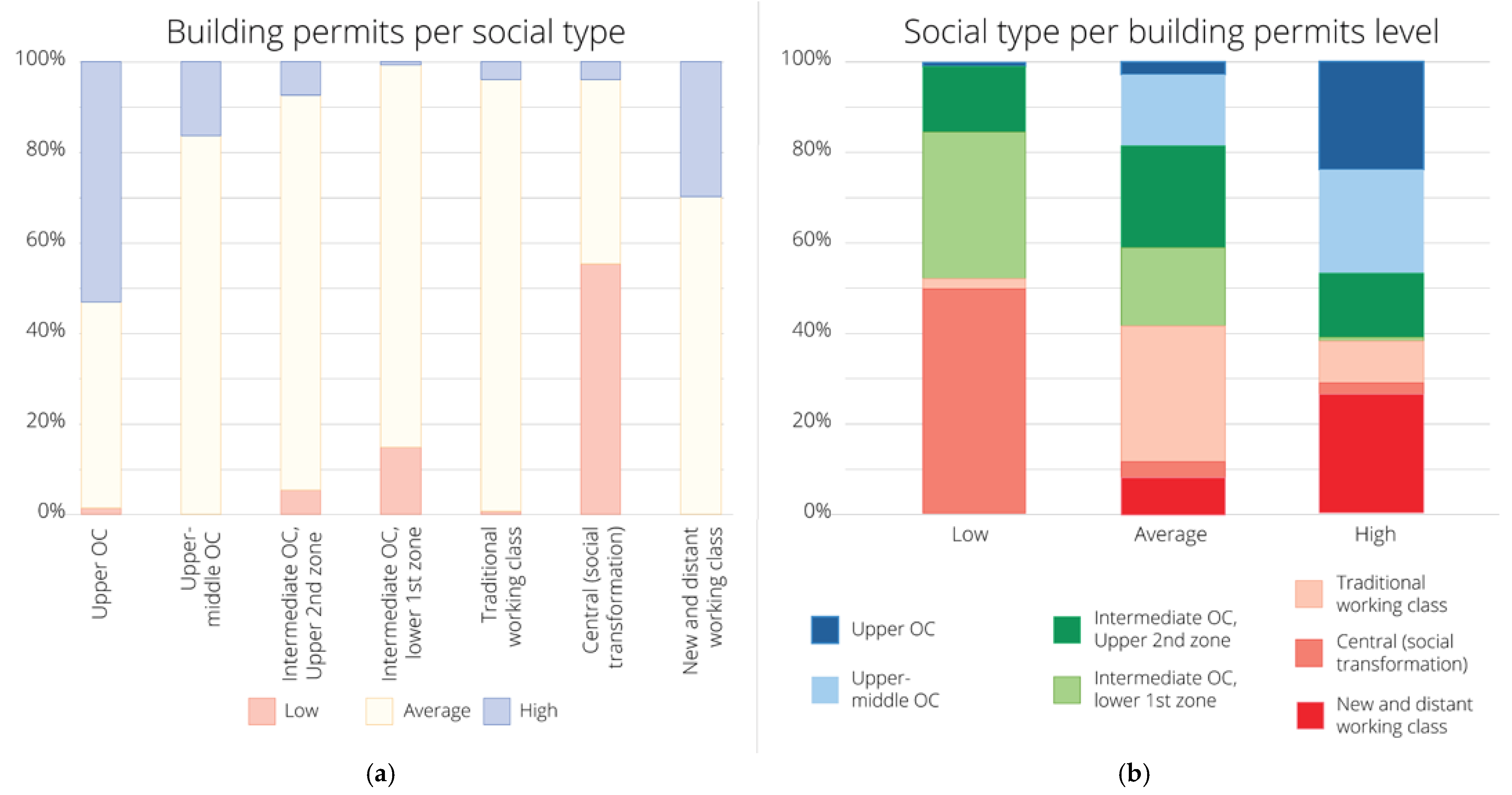
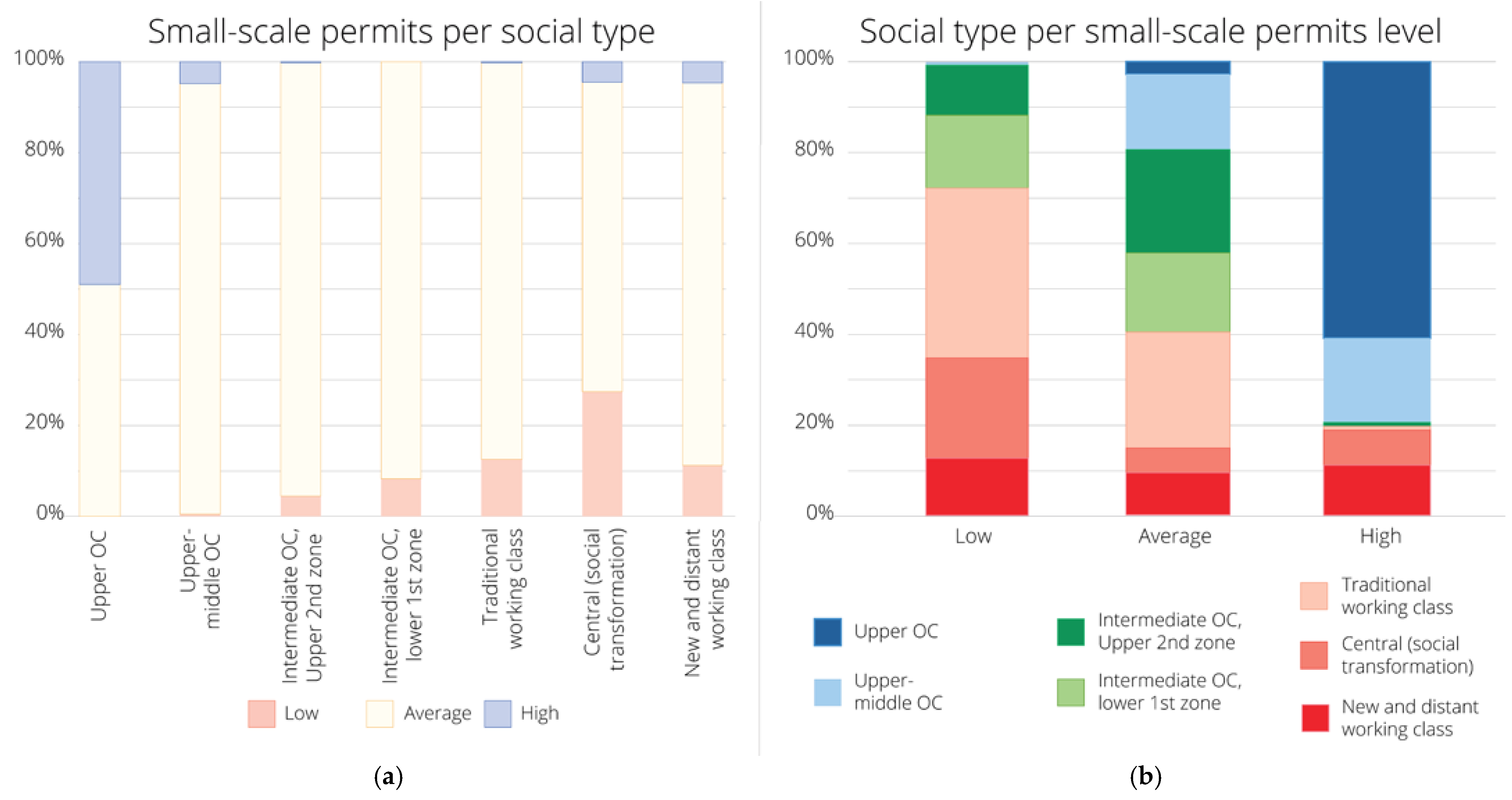
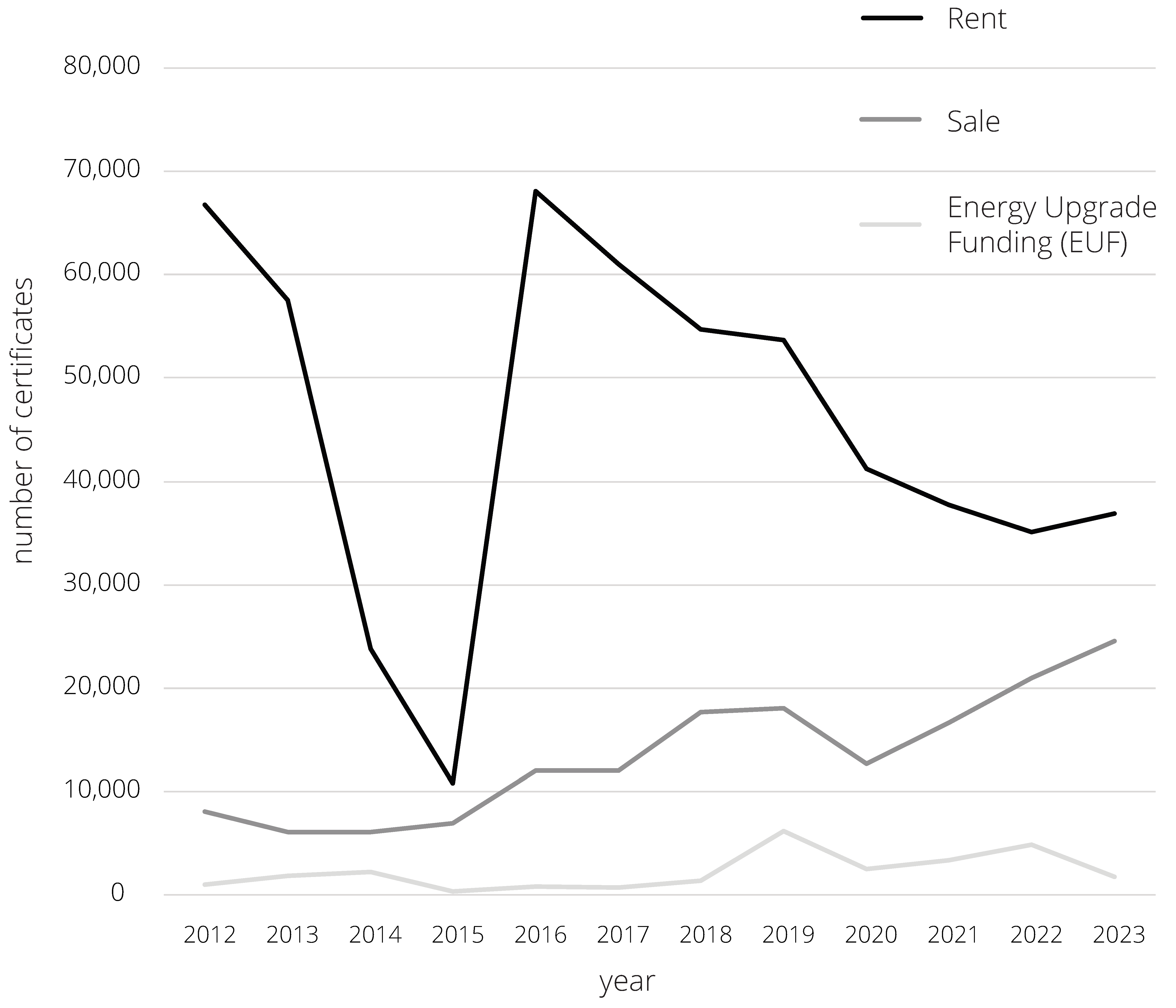

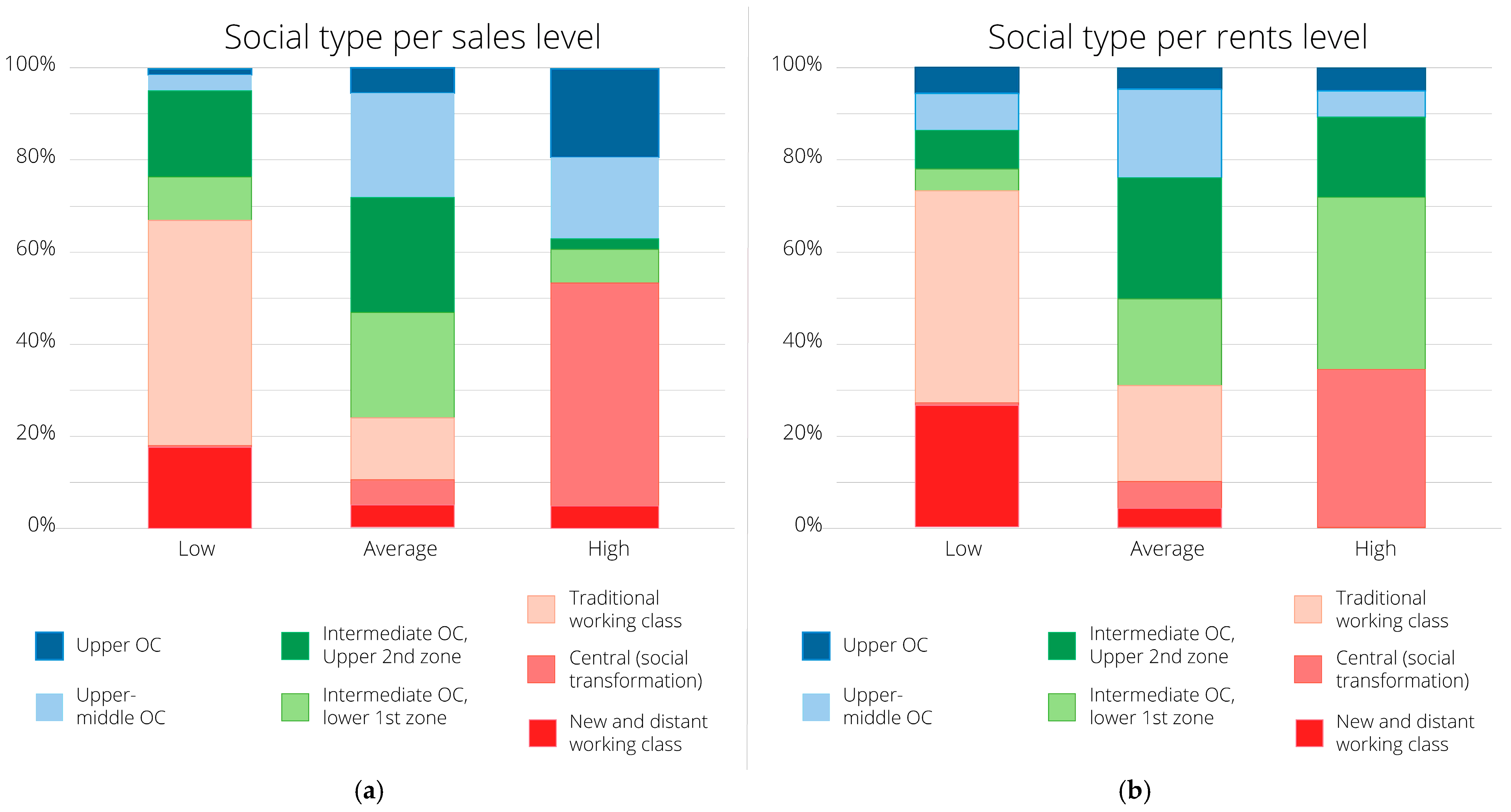
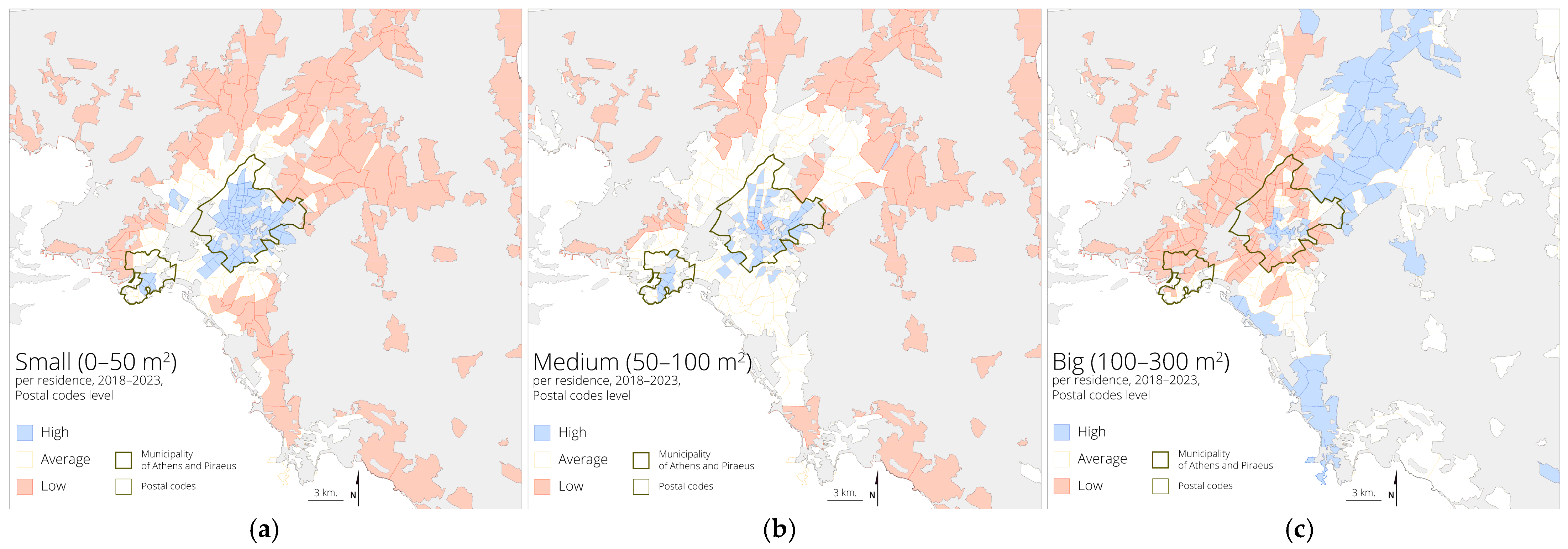
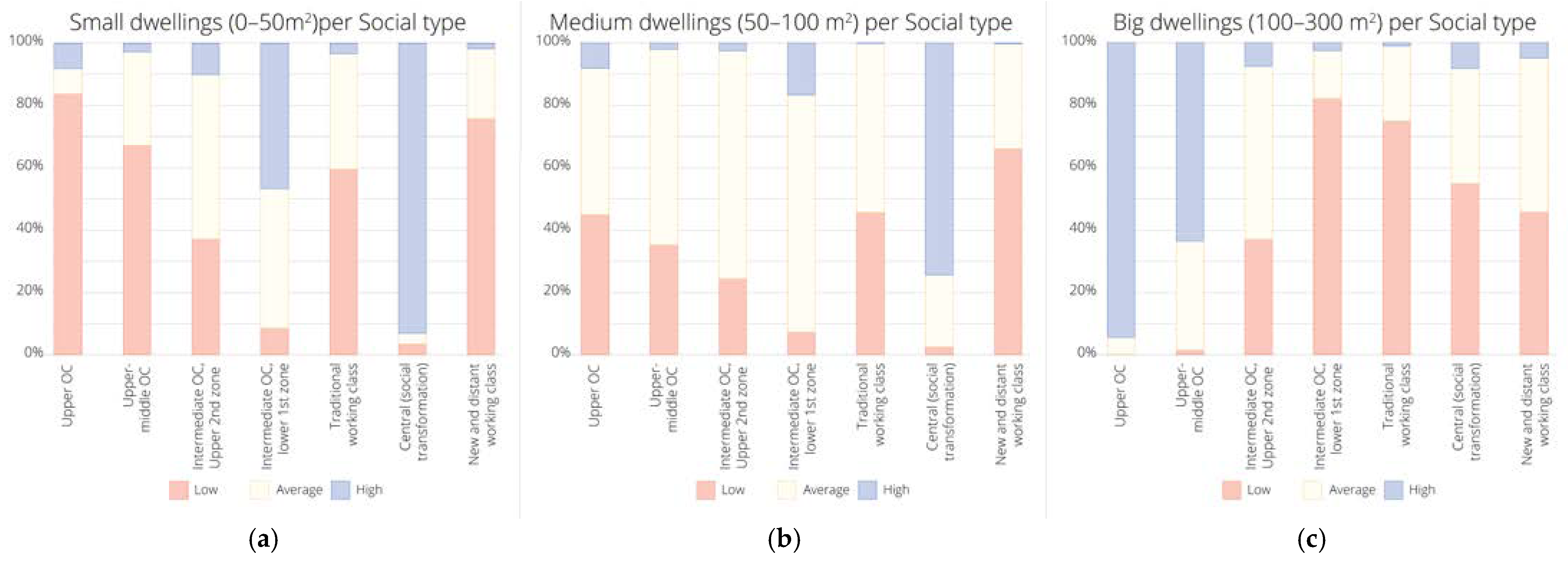
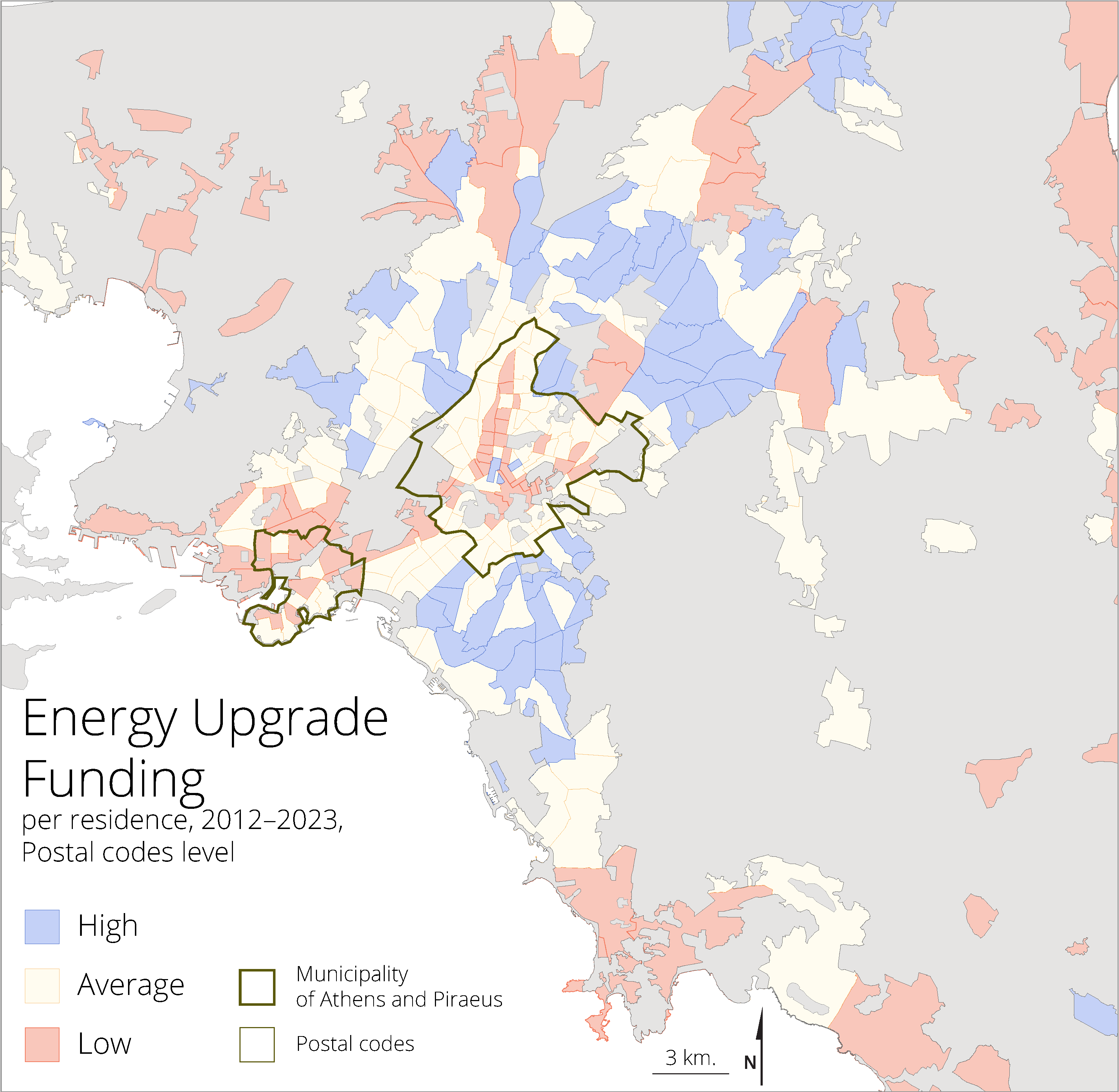
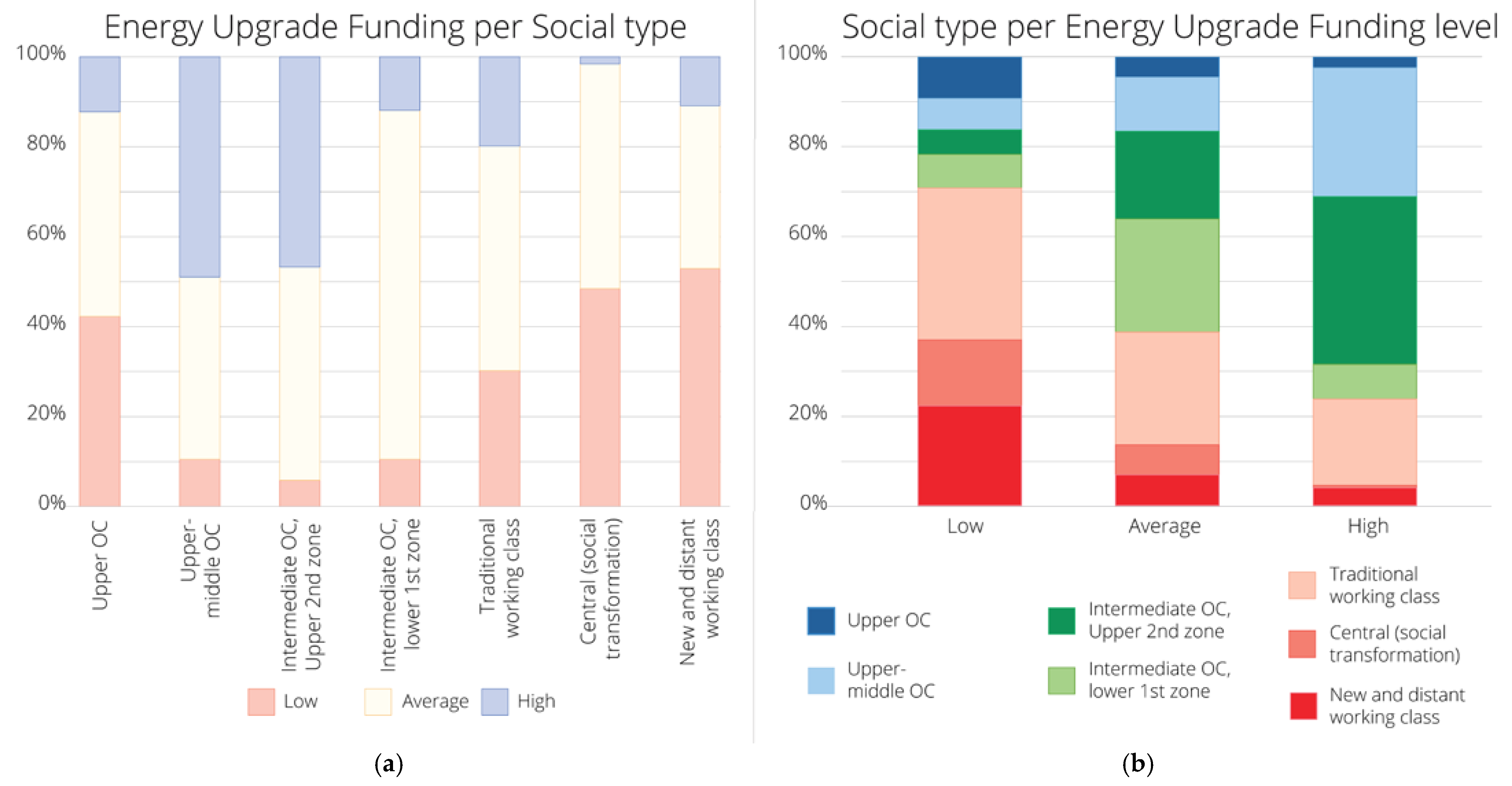
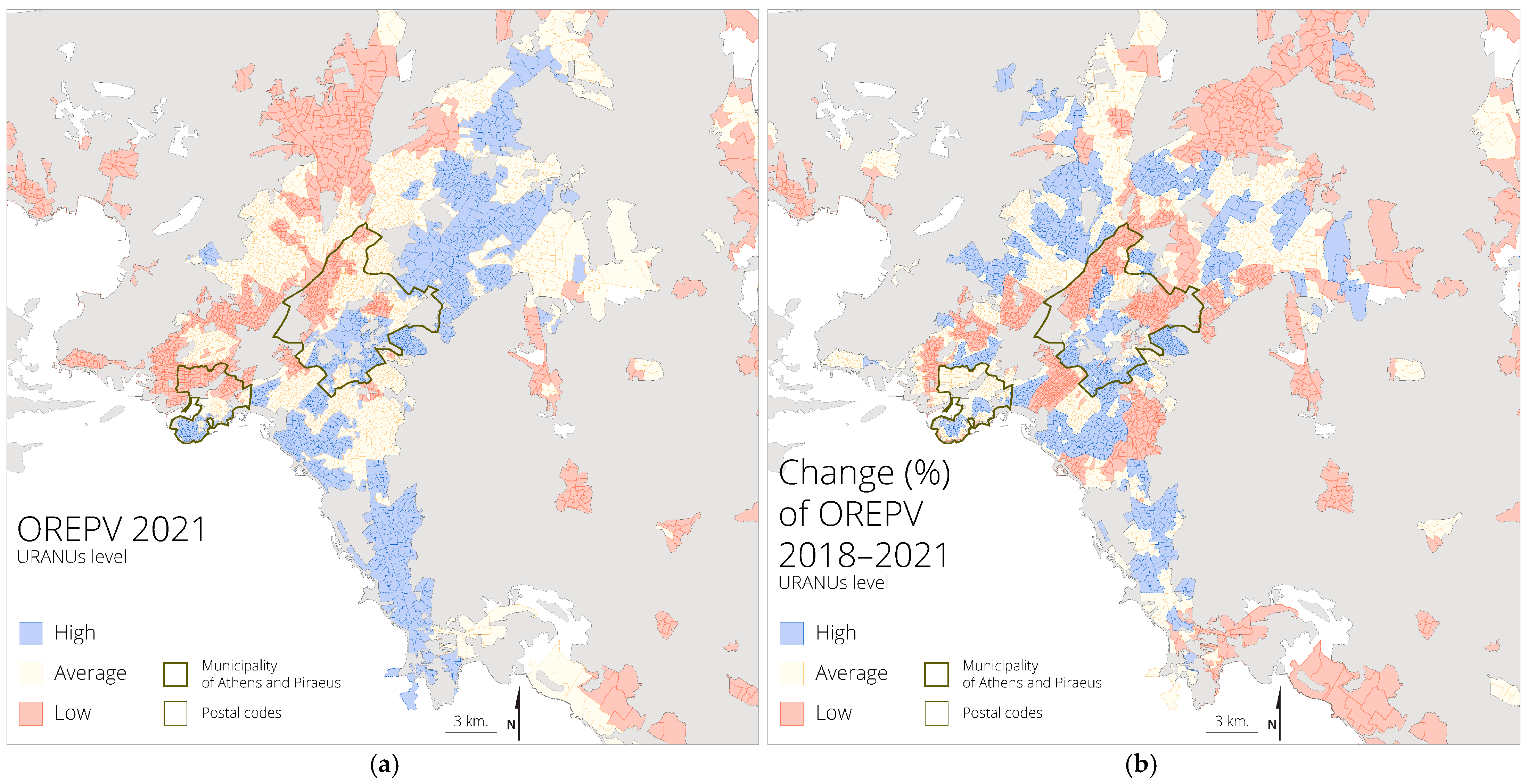
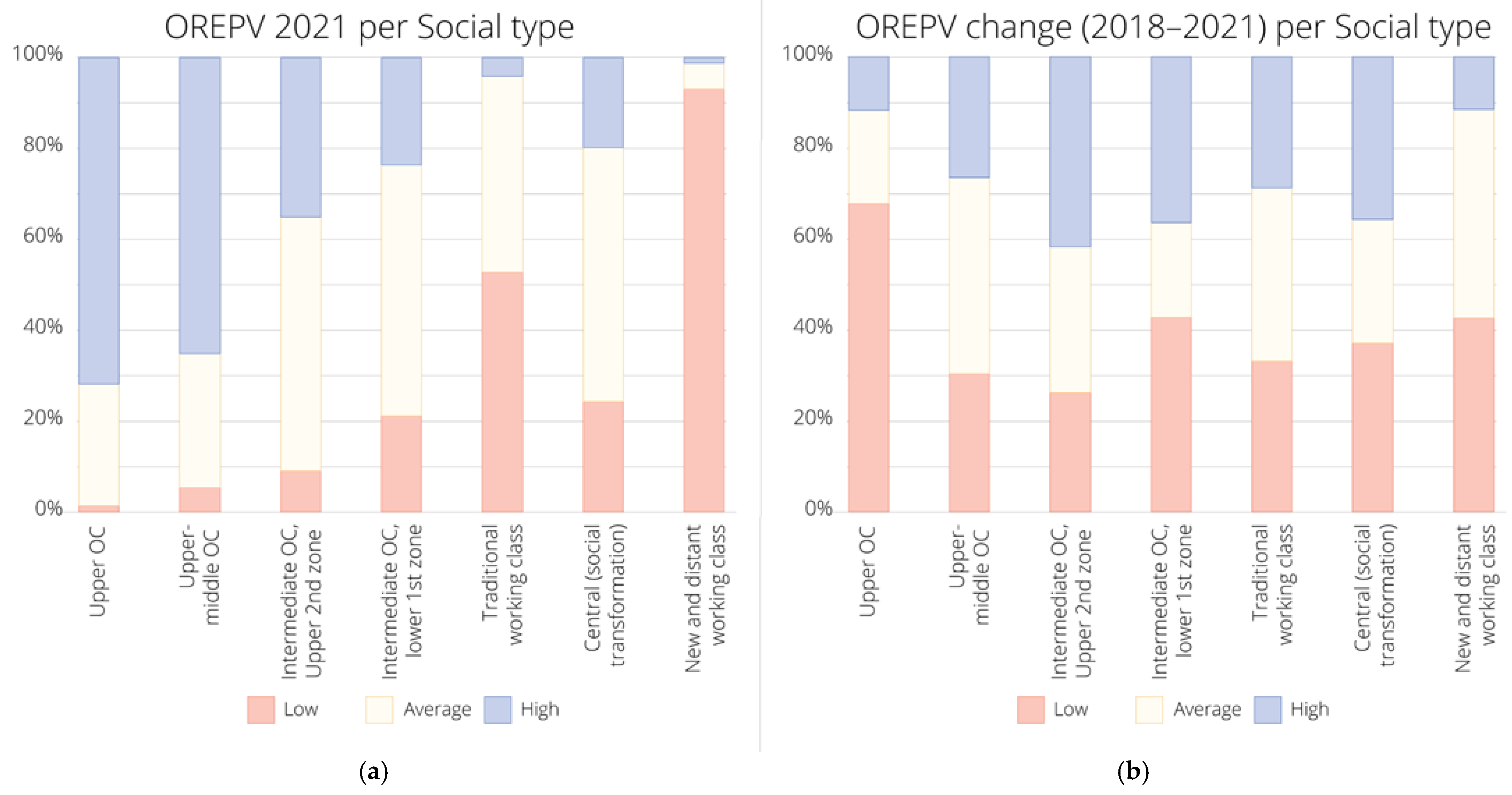
| Purpose | Number | Percentage (%) |
|---|---|---|
| Rent | 547,446 | 74.3% |
| Sales | 162,040 | 22.0% |
| Energy Upgrade Funding (EUF) | 27,278 | 3.7% |
| Total | 736,764 | 100.0% |
| Type of Permit | Number | Part (%) |
|---|---|---|
| Building permits | 12,542 | 16.6% |
| Small-scale works permits | 62,792 | 83.4% |
| Total | 75,334 | 100.0% |
| Social Profile of Residential Areas | Tenants | Higher Education (Age 22+) | Higher OC (ISCO 1 and 2) | Lower OC (ISCO 6 to 9) | Immigrants |
|---|---|---|---|---|---|
| Upper OC | 0.76 | 2.33 | 2.09 | 0.43 | 0.53 |
| Upper-middle | 0.88 | 1.68 | 1.59 | 0.55 | 0.47 |
| Intermediate OC, Upper 2nd zone | 0.96 | 1.04 | 1.07 | 0.79 | 0.60 |
| Intermediate OC, lower 1st zone | 1.26 | 0.89 | 0.87 | 1.03 | 1.33 |
| Traditional working-class | 0.84 | 0.56 | 0.70 | 1.17 | 0.76 |
| Central (social transformation) | 1.82 | 1.09 | 0.85 | 1.38 | 3.15 |
| New and distant working-class | 0.71 | 0.41 | 0.52 | 1.63 | 1.22 |
| Total | 1 | 1 | 1 | 1 | 1 |
| Social Profile of Residential Areas | In Apartment Buildings | In Conditions of Housing Poverty (<20 m2 per capita) | Up to 50 m2 * | Between 50–90 m2 * | Between 90–300 m2 * |
|---|---|---|---|---|---|
| Upper OC | 0.78 | 0.22 | 0.33 | 3.99 | 1.86 |
| Upper-middle | 1.02 | 0.48 | 0.48 | 2.08 | 1.55 |
| Intermediate OC, Upper 2nd zone | 1.12 | 0.85 | 0.79 | 0.73 | 1.00 |
| Intermediate OC, lower 1st zone | 1.25 | 1.15 | 1.44 | 0.38 | 0.65 |
| Traditional working-class | 0.87 | 1.18 | 0.90 | 0.60 | 0.85 |
| Central (social transformation) | 1.38 | 1.39 | 2.22 | 0.44 | 0.59 |
| New and distant working-class | 0.45 | 1.47 | 1.09 | 0.95 | 1.04 |
| Total | 1 | 1 | 1 | 1 | 1 |
| Purpose | Size in m2 (%) | Energy Class (%) | ||||
|---|---|---|---|---|---|---|
| Small (0–50 m2) | Medium (50–100 m2) | Big (100–300 m2) | High (A, B) | Average (C, D) | Low (E, F, G) | |
| Rent | 20.4 | 61.9 | 17.7 | 2.4 | 27.2 | 70.3 |
| Sales | 18.5 | 56.1 | 25.4 | 3.6 | 23.0 | 73.4 |
| Energy Upgrade Funding (EUF) | 3.8 | 58.7 | 37.5 | 35.8 * | 43.1 * | 21.1 * |
| Total | 19.3 | 60.5 | 20.2 | 3.9 | 26.9 | 69.2 |
Disclaimer/Publisher’s Note: The statements, opinions and data contained in all publications are solely those of the individual author(s) and contributor(s) and not of MDPI and/or the editor(s). MDPI and/or the editor(s) disclaim responsibility for any injury to people or property resulting from any ideas, methods, instructions or products referred to in the content. |
© 2025 by the authors. Licensee MDPI, Basel, Switzerland. This article is an open access article distributed under the terms and conditions of the Creative Commons Attribution (CC BY) license (https://creativecommons.org/licenses/by/4.0/).
Share and Cite
Maloutas, T.; Spyrellis, S.N.; Vatavali, F. Unregulated Urban Regeneration in Athens: Greening and Taxation of the Built Environment as Impending Levers of Increasing Inequalities. Land 2025, 14, 777. https://doi.org/10.3390/land14040777
Maloutas T, Spyrellis SN, Vatavali F. Unregulated Urban Regeneration in Athens: Greening and Taxation of the Built Environment as Impending Levers of Increasing Inequalities. Land. 2025; 14(4):777. https://doi.org/10.3390/land14040777
Chicago/Turabian StyleMaloutas, Thomas, Stavros Nikiforos Spyrellis, and Fereniki Vatavali. 2025. "Unregulated Urban Regeneration in Athens: Greening and Taxation of the Built Environment as Impending Levers of Increasing Inequalities" Land 14, no. 4: 777. https://doi.org/10.3390/land14040777
APA StyleMaloutas, T., Spyrellis, S. N., & Vatavali, F. (2025). Unregulated Urban Regeneration in Athens: Greening and Taxation of the Built Environment as Impending Levers of Increasing Inequalities. Land, 14(4), 777. https://doi.org/10.3390/land14040777









